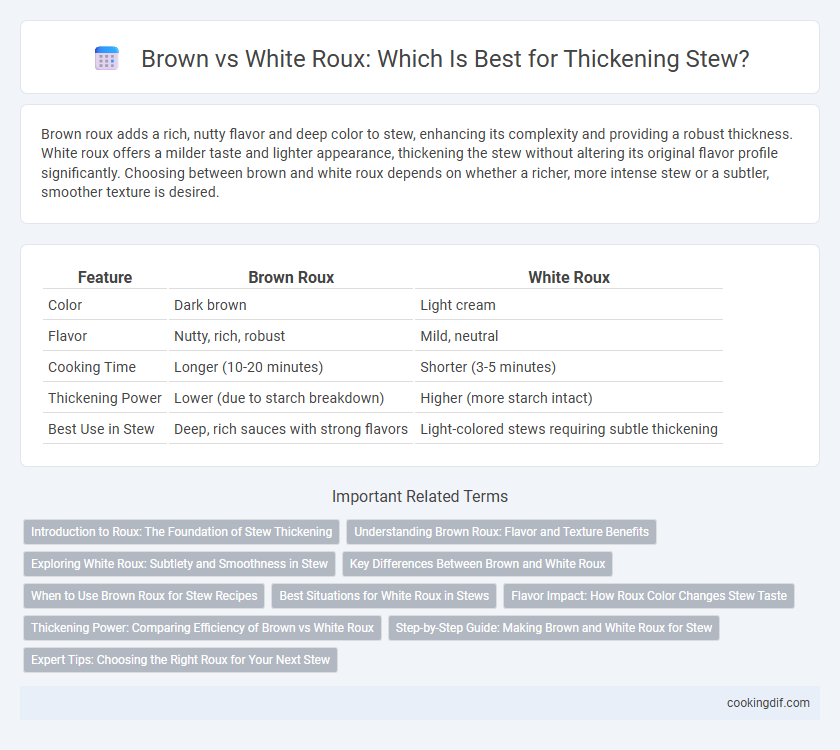Brown roux adds a rich, nutty flavor and deep color to stew, enhancing its complexity and providing a robust thickness. White roux offers a milder taste and lighter appearance, thickening the stew without altering its original flavor profile significantly. Choosing between brown and white roux depends on whether a richer, more intense stew or a subtler, smoother texture is desired.
Table of Comparison
| Feature | Brown Roux | White Roux |
|---|---|---|
| Color | Dark brown | Light cream |
| Flavor | Nutty, rich, robust | Mild, neutral |
| Cooking Time | Longer (10-20 minutes) | Shorter (3-5 minutes) |
| Thickening Power | Lower (due to starch breakdown) | Higher (more starch intact) |
| Best Use in Stew | Deep, rich sauces with strong flavors | Light-colored stews requiring subtle thickening |
Introduction to Roux: The Foundation of Stew Thickening
Roux, a mixture of flour and fat cooked together, serves as the fundamental thickening agent in stew preparation. Brown roux, cooked longer to develop a deeper flavor and darker color, imparts a rich, nutty taste while providing moderate thickening power. In contrast, white roux, cooked briefly to retain its pale color, offers stronger thickening ability with a more neutral flavor, making it ideal for lighter stews.
Understanding Brown Roux: Flavor and Texture Benefits
Brown roux offers a rich, nutty flavor and deep amber color that enhances the complexity of stews, providing a more robust taste compared to white roux. Its longer cooking time develops caramelized notes that contribute to a thicker, velvety texture by effectively binding with the liquid. Using brown roux not only improves the stew's mouthfeel but also intensifies savory flavors, making it a preferred choice for hearty, slow-cooked dishes.
Exploring White Roux: Subtlety and Smoothness in Stew
White roux, cooked briefly to retain its pale color, offers a subtle and smooth thickening agent ideal for delicate stews. Its mild flavor allows the natural ingredients' taste to shine without overpowering, creating a refined texture that enhances consistency. Chefs often favor white roux when clarity and gentle thickening are essential to maintain the stew's nuanced flavors.
Key Differences Between Brown and White Roux
Brown roux is cooked longer, developing a deep, nutty flavor and rich brown color that adds robust taste to stews, while white roux is cooked briefly to maintain a pale color and mild flavor, ideal for subtle thickening. Brown roux has less thickening power due to extended cooking breaking down starch granules, whereas white roux provides stronger thickening but minimal flavor contribution. Choosing between the two depends on whether the stew requires intense flavor enhancement or a delicate, creamy texture.
When to Use Brown Roux for Stew Recipes
Brown roux is ideal for stews that require a deeper, richer flavor and a darker color, often used in recipes with robust meats like beef or game. The longer cooking time of brown roux develops nutty, caramelized notes that intensify the stew's overall savory profile. Use brown roux when a stew benefits from a heartier taste and a thick, velvety texture that complements slow-cooked ingredients.
Best Situations for White Roux in Stews
White roux is best suited for delicate, light-colored stews where maintaining a subtle flavor and pale appearance is essential, such as chicken or vegetable-based stews. Its mild taste ensures the stew's original ingredients shine without adding the nutty or toasted notes that brown roux imparts. White roux also thickens quickly, making it ideal for dishes requiring a smooth, creamy texture without overpowering the broth.
Flavor Impact: How Roux Color Changes Stew Taste
Brown roux imparts a deep, nutty flavor that enhances the savory richness of stews, offering a complex and robust taste profile. White roux provides a milder, more neutral base that thickens without altering the original flavors significantly, allowing the natural ingredients to dominate. The choice between brown and white roux directly influences the stew's aroma and depth, tailoring the flavor intensity to suit different culinary preferences.
Thickening Power: Comparing Efficiency of Brown vs White Roux
Brown roux offers a richer flavor but has less thickening power compared to white roux due to its longer cooking time breaking down starch molecules. White roux thickens more efficiently and quickly because it retains more intact starch, making it ideal for achieving a thicker stew base. Choosing between them depends on balancing desired flavor depth with the stew's consistency requirements.
Step-by-Step Guide: Making Brown and White Roux for Stew
Start by melting equal parts butter and flour, cooking the mixture over medium heat; for white roux, cook until pale and bubbly, about 2-3 minutes, ensuring it retains a light color to preserve mild flavor and thickening power. For brown roux, continue cooking and stirring until the mixture turns a nutty brown, typically 5-7 minutes, to develop a richer, deeper flavor ideal for hearty stews. Gradually whisk the roux into the stew liquid to avoid lumps, allowing it to simmer until the desired thickness and smooth consistency is achieved.
Expert Tips: Choosing the Right Roux for Your Next Stew
Brown roux, cooked longer to develop a nutty flavor and deep color, enhances the richness of hearty stews, making it ideal for beef or game recipes. White roux, cooked briefly to maintain a mild taste and lighter color, provides a smooth thickening base perfect for delicate stews with chicken or seafood. Experts recommend adjusting roux color and cooking time based on desired stew flavor and appearance to achieve optimal texture and taste.
Brown vs White Roux for thickening stew Infographic

 cookingdif.com
cookingdif.com